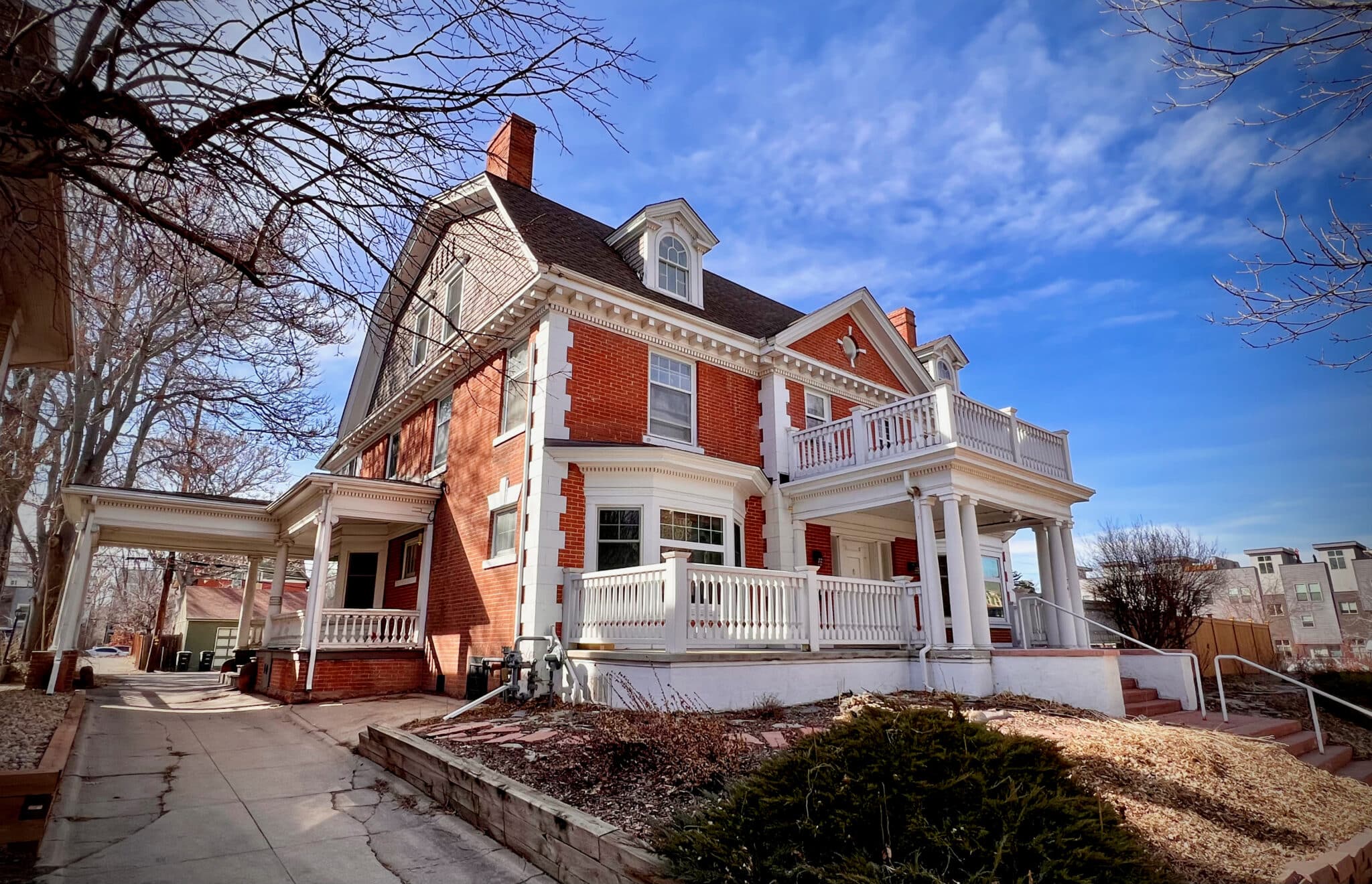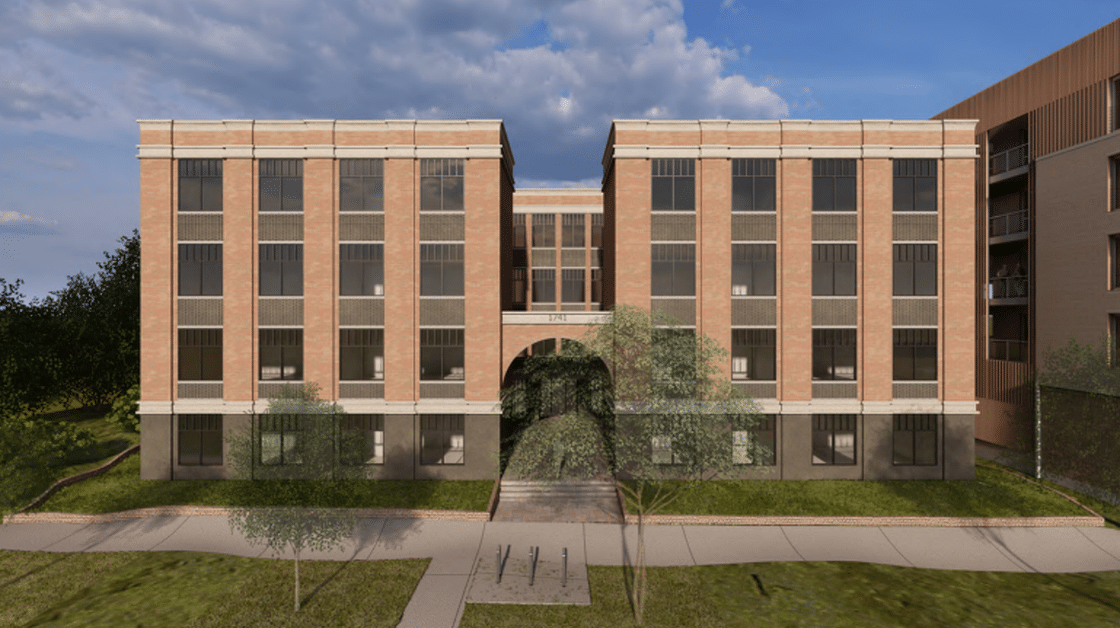
The home at 1741 Gaylord St. dates to the early 1900s. (Courtesy Historic Denver)
A 120-year-old home in the City Park West neighborhood won’t be coming down.
The Denver City Council voted 10-0 Monday evening to designate the structure at 1741 Gaylord St. a city landmark, scuttling the property owner’s plans to demolish the home and construct an apartment building with some income-restricted units.
It’s just the second time the council has voted to landmark a structure against the wishes of its owner.
Councilwoman Amanda Sawyer called owner-opposed landmark applications “unfair,” and said she’d previously been surveyed about whether she could support one.
“My response was, it would have to be extraordinary,” Sawyer said. “I think we have before us tonight an example of extraordinary.”
Several council members, including Chris Hines and Kendra Black, said they believe the building could be repurposed into multiple residential units, as preservationists had argued. Councilman Paul Kashmann said the previous occupants were indeed notable.
Councilwoman Candi CdeBaca, meanwhile, described the situation as “perhaps the most perfect and most egregious example of what’s happening to this city.”
“We have a developer who can actually look at this building and see nothing but dollar signs … We have all run out of patience and tolerance for this type of treatment,” CdeBaca said.

Michael Mathieson at a property he owns in RiNo on Friday, March 31, 2023. (Hyoung Chang/The Denver Post)
Property owner and developer Mike Mathieson had predicted the outcome, telling BusinessDen prior to the vote that “we are going to lose for sure” and that he would likely sue.
Council members Chris Herndon, Kevin Flynn and Stacie Gilmore were absent from the vote. But those voting yes included Councilwoman Amanda Sandoval, whom an attorney for Mathieson emailed last week asking she recuse herself, citing interactions she’d had with Mathieson since he bought a property in Berkeley from Sandoval’s family members years ago. (“I have no conflict of interest on this property,” Sandoval responded.)
The brick house at 1741 Gaylord dates to 1902. The three Denver residents — Scott Holder, Karen Herbert and Peggy Muldoon — who applied for the designation argued the building should be saved because it’s a good example of the Dutch Colonial Revival style, because its early occupants were notable and because it was designed by a notable architecture firm, Gove & Walsh.
The home originally was constructed for Edward Holmes Hurlbut, a local grocer, and was later owned by James and Edith Burger. James was a banker and state senator for four years, while Edith helped start Children’s Hospital Colorado, according to the applicants.
In his comments, Holder focused on Edith Burger, saying her “story was lost to us for over 100 years,” but became known during the process of researching the home’s past.
“That important story risks being lost again,” he said, if the home were destroyed.

A rendering of the apartment building owner and developer Mike Mathieson hoped to build at the site. (Courtesy ZPD+A Architects)
Adam Wilmot, an architect with ZPD+A Architects speaking on behalf of Mathieson, said the extent of the former occupants’ contributions to Denver history could be “also attributed to thousands of other residents,” and said the building was a mix of Colonial styles, with Dutch Colonial Revival not even being the leading one.
“Put simply, it’s a nice crossbreed,” he said. “It doesn’t qualify as a purebred that’s qualified to win best in show.”
Wilmot and Mathieson’s attorney Parker Semler argued the applicants didn’t have concrete evidence to back up some of their claims.
“We urge you to choose affordable housing … over preserving the memory of a few affluent residents,” Wilmot added.
Mathieson’s latest plans to redevelop the property called for a 54-unit project with at least five units restricted to those making up to 60 percent of the area median income, or AMI. He said he planned to make the remaining units affordable to those making between 80 to 120 percent AMI.
A city staffer said Denver received 136 comments or petition signatures in support of landmark status and 99 in opposition. The nonprofit Historic Denver and former Mayor Wellington Webb advocated for preservation, as did the majority of those who spoke at the Monday meeting.

The home at 1741 Gaylord St. dates to the early 1900s. (Courtesy Historic Denver)
A 120-year-old home in the City Park West neighborhood won’t be coming down.
The Denver City Council voted 10-0 Monday evening to designate the structure at 1741 Gaylord St. a city landmark, scuttling the property owner’s plans to demolish the home and construct an apartment building with some income-restricted units.
It’s just the second time the council has voted to landmark a structure against the wishes of its owner.
Councilwoman Amanda Sawyer called owner-opposed landmark applications “unfair,” and said she’d previously been surveyed about whether she could support one.
“My response was, it would have to be extraordinary,” Sawyer said. “I think we have before us tonight an example of extraordinary.”
Several council members, including Chris Hines and Kendra Black, said they believe the building could be repurposed into multiple residential units, as preservationists had argued. Councilman Paul Kashmann said the previous occupants were indeed notable.
Councilwoman Candi CdeBaca, meanwhile, described the situation as “perhaps the most perfect and most egregious example of what’s happening to this city.”
“We have a developer who can actually look at this building and see nothing but dollar signs … We have all run out of patience and tolerance for this type of treatment,” CdeBaca said.

Michael Mathieson at a property he owns in RiNo on Friday, March 31, 2023. (Hyoung Chang/The Denver Post)
Property owner and developer Mike Mathieson had predicted the outcome, telling BusinessDen prior to the vote that “we are going to lose for sure” and that he would likely sue.
Council members Chris Herndon, Kevin Flynn and Stacie Gilmore were absent from the vote. But those voting yes included Councilwoman Amanda Sandoval, whom an attorney for Mathieson emailed last week asking she recuse herself, citing interactions she’d had with Mathieson since he bought a property in Berkeley from Sandoval’s family members years ago. (“I have no conflict of interest on this property,” Sandoval responded.)
The brick house at 1741 Gaylord dates to 1902. The three Denver residents — Scott Holder, Karen Herbert and Peggy Muldoon — who applied for the designation argued the building should be saved because it’s a good example of the Dutch Colonial Revival style, because its early occupants were notable and because it was designed by a notable architecture firm, Gove & Walsh.
The home originally was constructed for Edward Holmes Hurlbut, a local grocer, and was later owned by James and Edith Burger. James was a banker and state senator for four years, while Edith helped start Children’s Hospital Colorado, according to the applicants.
In his comments, Holder focused on Edith Burger, saying her “story was lost to us for over 100 years,” but became known during the process of researching the home’s past.
“That important story risks being lost again,” he said, if the home were destroyed.

A rendering of the apartment building owner and developer Mike Mathieson hoped to build at the site. (Courtesy ZPD+A Architects)
Adam Wilmot, an architect with ZPD+A Architects speaking on behalf of Mathieson, said the extent of the former occupants’ contributions to Denver history could be “also attributed to thousands of other residents,” and said the building was a mix of Colonial styles, with Dutch Colonial Revival not even being the leading one.
“Put simply, it’s a nice crossbreed,” he said. “It doesn’t qualify as a purebred that’s qualified to win best in show.”
Wilmot and Mathieson’s attorney Parker Semler argued the applicants didn’t have concrete evidence to back up some of their claims.
“We urge you to choose affordable housing … over preserving the memory of a few affluent residents,” Wilmot added.
Mathieson’s latest plans to redevelop the property called for a 54-unit project with at least five units restricted to those making up to 60 percent of the area median income, or AMI. He said he planned to make the remaining units affordable to those making between 80 to 120 percent AMI.
A city staffer said Denver received 136 comments or petition signatures in support of landmark status and 99 in opposition. The nonprofit Historic Denver and former Mayor Wellington Webb advocated for preservation, as did the majority of those who spoke at the Monday meeting.
